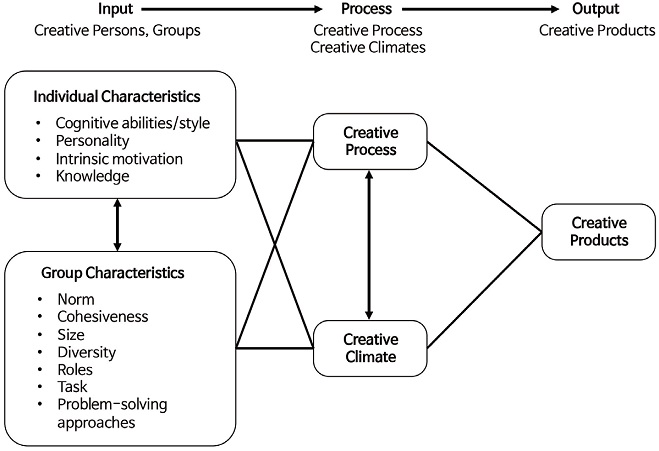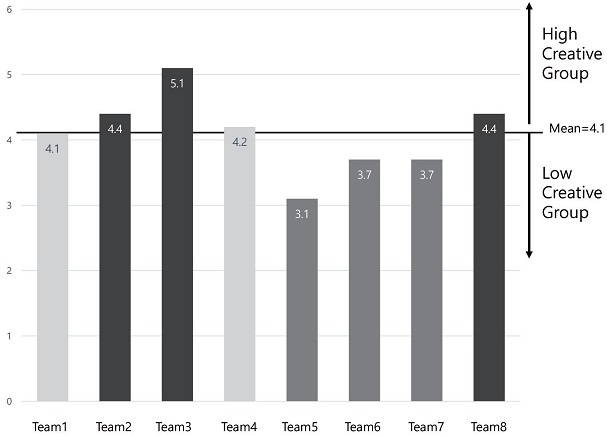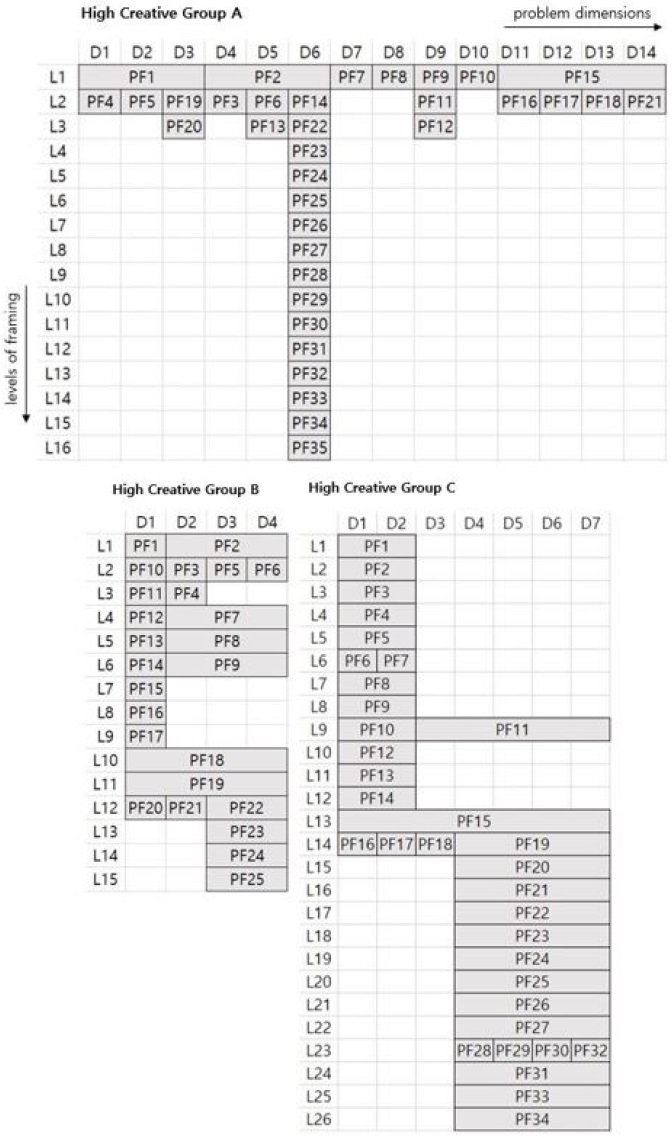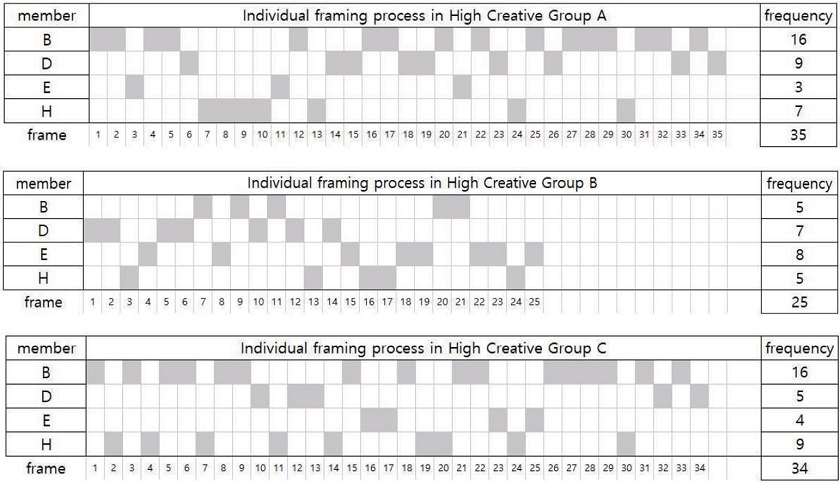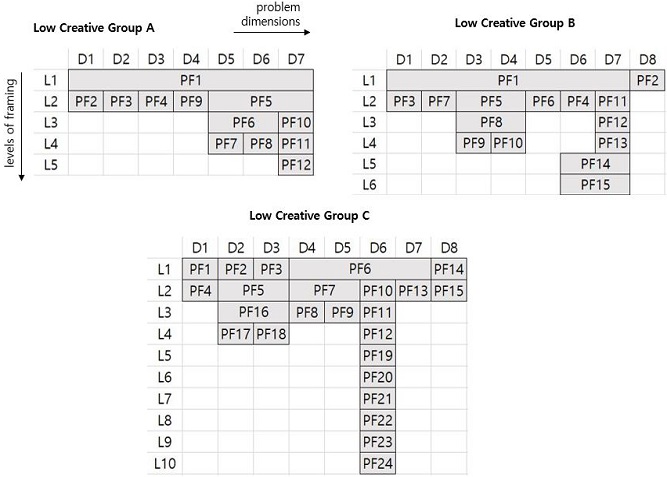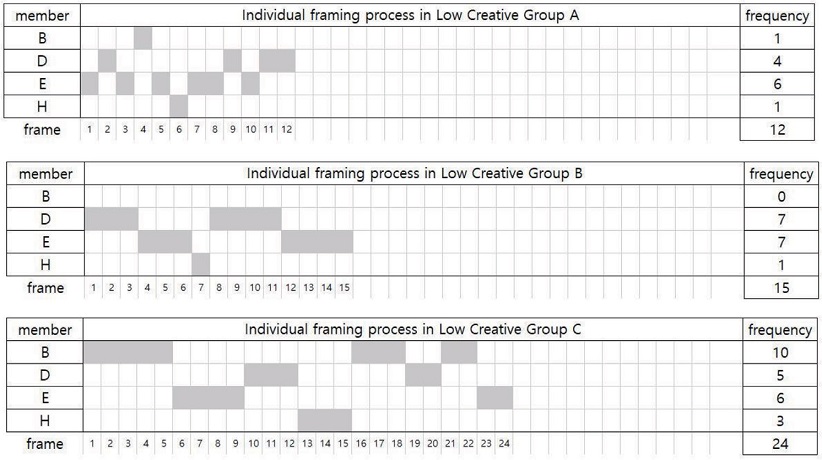
Problem Framing Activities Carried Out by Student Design Teams to Enhance Creativity: Comparative Analysis of High and Low Creative Teams
Abstract
Background Problem framing has been recognized as a creative step towards innovation, and as such, its capacity to restructure ill-defined problems is considered a core design practice. Since a key concern within design education is encouraging students’ ability to solve problems in a creative way, they are often requested to conduct problem-solving tasks in the design studio, as a way of achieving creative results. Unlike experienced designers who are adept at creating and embracing frames deliberately, students are often incapable of dealing with complex design problems. Thus, it is necessary to investigate problem framing activities amongst student design teams as a way of fostering creativity in design education.
Methods In order to determine problem framing activities carried out by student design teams, an empirical study of high and low creative groups of students was designed, and a design problem-solving task was implemented. A protocol analysis method was deployed to uncover distinctive problem framing activities carried out by student design teams with respect to creativity.
Results Based on the protocol analysis, the problem framing activities of six teams of high and low creative groups were identified, according to the following process. First, there was a presentation of how each group produced multiple frames, extracting diverse themes from the problematic situation. Second, how each group framed one of the specific problems in depth was described. Third, how each group built collective frames in cooperation with group members was discussed. Fourth, based on a comparative analysis of high and low creative groups’ problem framing activities, the distinctive features associated with creativity were identified. Fifth, educational insights for promoting creativity amongst student design teams were drawn.
Conclusions This study is distinguished from previous studies on problem framing in design education in that it views problem framing as a critical practice to promote creativity. This study provides empirical evidence involving problem framing activities carried out by student design teams in relation to creativity. The results of this study are beneficial to educators and facilitators in creative professions, in their supply of a comprehensive understanding of the problem framing activities used by novice design teams to foster creativity.
Keywords:
Problem Framing, Design Teams, Creativity, Design Education1. Research background and purpose
As design problems tend to be complex and ill-defined, it is necessary for designers to be able to restructure problematic situations with their own frames in the early phase of the design process (Conklin, 2009; Kleinsmaan, 2006). Problem framing - distilling elements from problematic situations to form a new structure - has been recognized as a creative step that leads to original solutions (Paton, & Dorst, 2011). Guilford (1956) states that the capability to restructure problems leading to distinctive solutions is closely related to creativity. Dorst (2011) views framing as a core design practice leading to innovation. Christiaan (1992) outlines that a subject who spends more time defining a problem using their own frame and builds conceptual structures is better able to achieve creative results. However, for novices, time spent defining problems didn’t result in better design (Atman et al., 1999). It implies that framing problems is a prerequisite ability for designers who have little competence in dealing with the complexity of design problems (Dreyfus, & Dreyfus, 1980). Unlike experienced designers, who generally create or embrace a frame deliberately to achieve desired values, students come up with proposals randomly. (Dorst, 2011). Thus, it is essential to facilitate students’ effective framing of problems to achieve creative results.
As one of the main concerns of design education is to encourage students’ capacity to solve design problems (Gurel, & Potthoff, 2006), there have been studies on the development of pedagogical methodologies with an emphasis on problem framing in the context of design education. Self and Pei (2014) empirically examine how sketching stimulates students to frame design problems during the conceptual design process. Cardoso, Badke-Schaub and Eris (2016) determine how questions drive a multidisciplinary group of students in problem framing and idea generation. Gray’s study in 2019 investigated the problem framing process of students with an emphasis on ethical decision-making. Although problem framing is considered as an essential aspect of creativity in the design process (Dorst & Cross, 2001), there has been limited empirical attention to date paid to framing the design problem with respect to creativity.
Creativity in design is often described as a potential to produce new ideas (Gero, 1992). The capacity to restructure problems enables designers to perceive problematic situations in a different way, therefore it would provide more opportunities to become more creative in the design process (Ohlsson, 1984; Gero & Damski, 1997; Christiaans, 1992). Thus, it is essential to encourage problem framing in the design process in order to achieve creative results.
The objective of this study is to investigate how student design teams frame problems in the conceptual design process to enhance creativity in the context of design education. An empirical study involving comparative analysis of high and low creative teams of undergraduate students was designed to draw educational insights.
2. Research focus
2. 1. Problem Framing in Design Process
As a starting point for generating concepts, designers are challenged to tackle wicked problems and seek out what to focus on to find the best solutions (Dorst, & Cross, 2001; Kumar, 2013; Lawson, & Dorst, 2009; Schön, 1984). In the context of design, framing is defined as a means of selecting particular elements from complex situations (Schön, 1988). Designers restructure problems using frames and set boundaries of perspectives to determine focus (Kolko, 2010). Problem framing is one of the expert designer’s behaviors and it is widely considered as an essential characteristic of design expertise (Cross, 2004; Lawson & Dorst, 2009; Paton & Dorst, 2011). Student designers usually generate proposals at random without strategically approaching problems. Then, they attempt to match the proposals to the attainment of certain value (Dorst, 2011). Unlike the less-experienced designers who tend to employ deductive reasoning to deal with ill-structured problems, expert designers attempt to make solution conjectures early in the design process and tend to explore and define problem and solution collectively utilizing these conjectures (Lloyd and Scott, 1994; Cross, 2004). Based on their understanding of which problems are valuable to solve, the expert designers restrict the problem scope in the design process (Gray, 2019). In addition, expert designers often strategically deal with complex problems by developing a frame (Dorst, 2015). When the best expert designers find the central paradox in the problems, they tend to create new frames searching for the broader problem in the context (Dorst, 2011).
Good frames should be thought-provoking and provide a coherent standpoint for further thought, in addition to embodying a wide range of issues, and drawing more issues from the assigned problematic situation (Dorst, 2015). In order to explicitly identify the dimensions of a problem, designers create multiple frames that are either adopted or further developed during the design process. Reframing - described as a way of changing perspectives - is significant but difficult in the design process because it shifts designers’ perceptions towards a new perspective (Kolko, 2009). Such constructive perceptions enable designers to produce more creative ideas (Gero & Damski, 1997). Compared to the initially defined problem, when it is reframed it can lead to a novel solution (Dorst, 2011). Thus, framing and reframing design problems is a critical aspect to reach creativity.
The problem-solving process carried out by design teams also entails problem framing (Stumpf, & McDonnell, 2002). When working with team members, it is inevitable that one will have to manage diverse frames, as each team member may have a distinct perspective on the same subject. Therefore, reconciling multiple frames amongst team members is critical to building collective frames (Dorst, 2015). Based on the collective frames, design teams can mediate between the different opinions of stakeholders on certain issues, communicate with team members more explicitly and effectively (Conklin, 2009).
To sum up, in order to achieve creative solutions in the design process, first, it is necessary to create frames to determine the dimension and focus of a problem. Second, it is significant to reframe the initially defined problem to reach novel solution. Third, it is essential to reconcile multiple frames to build collective frames.
2. 2. Creativity of a Design Team
The creativity of a design team does not simply refer to an aggregation of the individual team members’ creativity (Rubin, 1984). Based on theories of creativity, Siau (1995) categorized the various components of group creativity into three dimensions – input, process, and output – and introduced the principle of collective creativity in Figure 1. Among the diverse components of group characteristics, this study concentrates on problem-solving approaches and creative products - the ideal outcome of the creative process.
In order to assess the creativity of outcomes, the Creative Product Semantic Scale (CPSS), which has been validated for more than a decade, is widely employed (Basemer & O’Quin, 1999). Based on the Creative Product Analysis Matrix theory (CPAM; Basemer & Treffinger, 1981), the CPSS includes the following three factors: Novelty, Resolution, and Elaboration and Synthesis. Novelty refers to newness of materials, concepts, processes, and ways of making the product. Resolution indicates the value of designed products with respect to functionality. Elaboration and Synthesis depict stylistic aspects of the product. Considering that the CPSS is widely employed to measure the creativity of products, this study considers Novelty, Resolution, and Elaboration and Synthesis as core dimensions to assess creative outcomes.
3. Methodology
In order to determine problem framing activities carried out by student design teams, an empirical study of eight interdisciplinary teams working on a conceptual design task was designed in a controlled laboratary setting. First, the creativity of their design outcomes was evaluated. Then, the design teams were classified into two groups – a more creative and a less creative group. A protocol analysis method (Ericsson, & Simon, 1993; Stempfle, & Badke-Schaub, 2002) was employed to address the following research questions: Are more creative groups distinguishable from less creative groups with respect to problem framing activities? And what problem framing activities should be considered as significant to promote the creativity of student design teams?
3. 1. Experimentation Setting
Each team was composed of four participants from different disciplines including design, business, engineering, and the humanities, and the ratio of male and female students was equal. In terms of levels of design expertise, Dreyfus and Dreyfus (1980) propose the five-stage process which consisted of novice, competence, proficiency, expertise, and mastery in relation to directed skill acquisition. In general, a student who just encounters design as a formal process is considered as a novice (Cross, 2004; Kim & Lee, 2016). An accumulation of deliberate training and experience are the essential prerequisite for reaching higher levels of expertise (Ericsson, Krampe & Tesch-Römer, 1993). Considering that the participants are inexperienced in the design problem solving process, the participants’ level of design knowledge and skills was described as novice. None of the team members had experience working together prior to the experiment. The participants were asked to propose a conceptual design to make the process of studying at university fun for students. The researcher requested that participants think aloud while solving the design problem. At the end of the design task, participants were required to articulate the team’s design proposal along with visual sketches. In order to investigate how the interdisciplinary teams restructured the design problem with their own frames, all team conversations were recorded.
3. 2. Assessing Creativity
In order to measure creativity, the articulations of the design concept produced by the eight interdisciplinary teams were assessed by five design professionals, who each had over ten years of experience in design education. The articulations were given to the experts in random order and they were asked to independently assess the concept articulations on a 7 point Likert scale - with 1 being “Poor” to 7 being “Excellent”. The final score for creativity was measured by taking the average of the scores on Novelty, Resolution, and Elaboration and Synthesis. Table 1 illustrates the mean scores of all experts in each category. The inter-rater reliability of all dimensions of creativity was .796.
Based on the score of final creativity, the interdisciplinary teams were classified into two extreme groups: a high creative group, including top three teams such as Team 2, Team 3, and Team 8, and a low creative group including Team 5, Team 6, and Team 7, which all received below the average score (See Figure 2). As we conducted a comparative analysis to investigate distinctions between high and low creative groups, Team 1 who received a mean score rating for final creativity and Team 4 whose score was near to the mean score were excluded from the analysis.
3. 3. Data Coding Procedure
In order to extract problem framing activities from the discourse of the high and low creative groups, the recorded conversations of six interdisciplinary teams were transcribed into transcripts. Based on the coding scheme, which originated from a literature review, two independent coders encoded the problem framing activities. The percentage of agreement between the two coders was 93.3%.
Table 3 describes how the coders encoded problem framing activities. In order to analyze how the design teams built collective frames collaboratively, the abbreviation for each participant’s discipline was recorded, along with the transcripts: ‘D’ is for ‘design-major student,’ ‘B’ is for ‘business-major student,’ ‘E’ is for ‘engineering-major student,’ and ‘H’ is for ‘human-major student’. After discussing differences in coding, the data was consolidated for analysis eliminating any vagueness. Table 4 depicts data collected from the high and low creative groups. In total, 145 problem framing activities were collected during the experiment.
3. 4. Data Analysis
Based on the encoded protocol data, the problem framing activities of the design teams were analyzed in the following ways. First, each group’s problem framing activities were analyzed, in terms of how they generated diverse, in-depth frames to determine the dimensions of problems, and how they built collective frames in cooperation with group members. Subsequently, a comparative analysis between high and low creative groups was presented.
4. Result
4. 1. Analysis of Problem Framing Activities of the High Creative Group
In order to investigate the problem framing activities of high creative groups, an analysis was conducted to determine how each group explored the problem dimensions widely and further framed them in depth.
In Figure 3, a rectangular box illustrates a unit of problem framing activities. The horizontal axis indicates problem dimensions on how each group distilled diverse themes from the given problem. The vertical axis depicts how deeply frames were further developed.
In terms of problem dimensions, the high creative group A extracted the most diverse themes from the problematic situation. Unlike the other groups, the group tried to extend the dimensions of the problem as much as possible and then selected the problem they deemed most worthwhile. What distinguished the group from others was that they were open to viewing the problem from diverse angles just as expert designers deliberately explore the context of problematic situations widely by searching for clues (Dorst, 2011). Table 5 describes how creative group A attempted to consider extensive possibilities through framing.
In terms of depth of framing, the high creative group C sequentially identified and explored the problem most deeply as depicted in Figure 3. This is uncommon behavior in that the group approached the ill-defined problem just like how novices deal with well-defined problems – ‘depth-first’ not ‘breadth-first’ (Cross, 2004). According to Ho’s study in 2001, designers, even novices, employ different problem solving strategies than those who coped with well-defined problems. Table 6 describes how creative group C linearly framed the problem.
Meanwhile, the high creative groups B and C had similar patterns of progression in the problem framing such as attempting to integrate several frames. As Figure 3 illustrates, PF8, PF15, and PF31 in the high creative group C were merged with the previous frames to embrace a wide range of problem dimensions. For group B, frames were converged twice (See PF7 and PF18 in Figure 3). First, since the frames from 2 to 6 were associated with inconveniences in a classroom, the group determined to focus on refining a classroom to make studying fun for students. Later, as the group discussed how to help students relax on campus, they combined the previous streams of frames together to design a multi-functional chair, which would help students study and relax in the classroom. This is similar to experts’ framing process in that they consider diverse aspects of the design problem in parallel with maintaining their opennesses and ambiguities (Lawson, 1994). Consequently, the student groups were able to reframe the problem by combining the previously suggested frames. Table 7 depicts how creative group B was open to considering all of the frames as potential themes and merged multiple frames in the design process.
In order to examine how the high creative group collaboratively built the collective frames, an analysis was carried out on how each group member shared individual frames with other members. Figure 4 illustrates how each group member participated in problem framing chronologically.
Among the high creative groups, group B built the collective frames most collaboratively; not only did each group member spend an almost equal length of time problem framing, but the diagrammatical flows of problem framing activities were also equally distributed. This implied that the problem framing progressed with the cooperation of all of the group members. Compared to group B, for the high creative groups’ A and C, individual participation in problem framing seemed imbalanced and was instead led by one of the group members. However, it was observed that both groups framed problems collaboratively and exchanged perspectives with one another. For instance, after group C determined to focus on redesigning a specific site in the library in PF19, the group continued to further frame the problem until the end of the process. As the diagrammatic flow illustrates between PF19 and PF34, all of the group members collectively framed the problem.
4. 2. Analysis of Problem Framing Activities of the Low Creative Group
The problem framing processes of the low creative group are illustrated in Figure 5. Overall, both the low creative groups A and B seldom extracted diverse themes and framed the problem in depth as well. However, the low creative group C approached problems from a somewhat broader range of angles. The group C started to subdivide the notion of studying into three parts - by taking a class, implementing a group study, and conducting an individual assignment. In addition, the group attempted to discover the reason why students were not able to study pleasantly, as well as suggesting how to make it more convenient for students to study.
Unlike experienced designers who think about what to create and how to reach the aspired value in parallel, (Dorst, 2011) the novice group seemed to be incapable of implementing a productive reasoning process. For instance, at the beginning of the design process, group B attempted to approach the problem with two frames – considering both what causes inconvenience for students at university and how to help students enjoy studying. However, group B only focused on the first frame in the context of creating convenient studying environments. Consequently, the group missed applying ‘fun’ elements to their final design concept. Additionally, when group B faced a challenge of matching the theme to the principle of how to make studying fun, the group suddenly changed their subject to the alternative instead of finding possible ways. This is in contrast with expert designers’ behavior who usually concentrate on finding clues around the problematic situations (Dorst, 2011). Table 8 illustrates how the group unexpectedly changed their themes from PF10 to PF11.
Figure 6 describes how the low creative group implemented problem framing collaboratively. As figure 6 illustrates, the individual group members’ problem framing activities were not evenly distributed. What was worse, a business student in group B didn’t participate in the framing at all, and humanities students in both groups A and B barely framed the problems. In addition, the low creative groups did not build frames interactively. For instance, as the design process began, each group member in group A started to consider diverse frames and ways of making studying fun for students. After each of them framed the problematic situation one after another, the group selected PF10, which one of the group members had suggested as a potential frame. It demonstrates that the low creative group A almost independently framed problems, rather than collaboratively building frames. Although the low creative group C produced more units of problem framing activities than the others, the group also framed problems somewhat individually. Table 9 illustrates how the group members in group C individually framed problems. Their problem dimensions were not associated with each other, which implies that collaboration in problem framing in the group did not progress successfully.
4. 3. Comparative Analysis of High and Low Creative Groups’ Problem Framing Activities
Based on the comparative analysis of high and low creative groups’ problem framing activities, significant features of the student design team associated with creativity were identified as follows.
In terms of problem dimension, most student design teams couldn’t frame the problems broadly. Compared to the high creative group A which created 14 frames regarding the problem scope, the other groups explored the limited scopes from the given problem producing less than eight frames. Although the capacity to extract themes from problematic situations has been emphasized as a means of reaching creativity, (Guilford, 1956; Paton, & Dorst, 2011) this study demonstrates that the student design teams had difficulty in expanding the problem dimensions by producing diverse frames.
Nevertheless, it was discovered that some of the student teams such as the high creative groups A and B often created a new frame by combining several frames together. This is significant to creativity in that reframing is considered as one of the ways to reach an innovative result.
Overall, the high creative group tended to dive deep into a problem dimension more thoroughly than the low creative group. As Figure 3 illustrates, the high creative groups kept framing and reframing the problem continuously up to 26 levels, where they managed to determine what to focus on in detail. In contrast, as Figure 5 illustrates, the low creative groups couldn’t go further in specifying the problem and stopped framing on levels between 4 and 10. Furthermore, the low creative group B was challenged by further framing the problem – indeed, they gave up and did not do a deep dive frame instead of either generating a sub-problem or refining the frame. This demonstrates that the high creative group produced more thought-provoking frames, which would identify more issues (Dorst, 2015).
Finally, with respect to ways of building collective frames, the high creative groups framed problems more collaboratively than the low creative groups. Unlike the problem frames of high creative groups, which mostly evolved from all of the group members interchanging their ideas with each other, the frames of the low creative group exclusively originated from singular group members. This implies that when a design team frames problems it would be better to work cooperatively rather than to select one of the best frames independently after framing.
5. Discussion and Conclusion
The aim of this study was to investigate the problem framing activities of high and low creative groups of students to enhance creativity in the context of design education. Based on the empirical analysis carried out in this study, educational insights on how to enhance creativity of student design teams with respect to problem framing were identified as follows.Firstly, in terms of the problem dimension, student design teams should be trained in searching for clues broadly in the context of the problem. This would provide more opportunities to create potential frames which lead to better designs (Atman et al, 1999) and prevent student design teams from framing restrictively.
Secondly, comprehending a productive reasoning process will better allow student design teams to frame ill-defined design. This process would help them consider what to create and how to reach the desired value in parallel – preserving an openness and an ambiguity in problem framing.
Thirdly, in order to reach creative results, we recommend student design teams try combining multiple frames they previously produced as a way of reframing. It would enable the novice design teams to view the problem from a different angle.
Finally, it is necessary to develop an educational methodology that increases individual group members’ participation in building collective frames. For instance, if each group member is required to (re)frame alternatively based on the other group members’ frames, it would make the team framing process more productive and collaborative.
The major contribution of this study is its view of problem framing as a catalyst to promote creativity and empirically investigate the problem framing activities of student design teams through a comparative analysis of high and low creative groups. This is significant to design research since there is a relative lack of literature providing empirical evidence on problem framing in the context of collaboration (Paton & Dorst, 2011; Stumpf & MaDonnell, 2002). The results of this study are beneficial in providing a comprehensive understanding of novice design teams’ problem framing process. In design education students have been less supported in learning cognitive skills like problem framing than they are supported in representational skills (Crismond & Adams, 2012). The implications of this study could form a basis to develop educational guidance for student design teams on how to deal with problems in the early phase of the design process.
As design is an integrated profession that covers a wide range of issues such as engineering, ergonomics, business, aesthetics, social environment, and culture, interdisciplinary collaboration is an essential part of the design process (Buchanan, 1992; Yang, You & Chen, 2005). In addition, the design industry requires designers to have integrated thinking and collaborative capabilities that lead to innovation. Therefore, collaborative design has been widely employed as a teaching methodology in design education to promote students’ creativity. For instance, in order to foster a creative designer with expertise in solving design problems, instructors often get students to conduct in-class design projects within interdisciplinary teams (Chan, & Cheng, 2001; Kim, et al, 2015; Kwon, & Jang, 2013; Lee, 2014). In this regard, this study will provide insights about team problem framing with respect to creativity for educators and facilitators who deal with ill-defined problems in diverse professions. The results of this study will also provide a comprehensive understanding of how interdisciplinary teams of students embrace various perspectives while framing an ill-structured problem in a collaborative manner during the early phase of the design process. Based on this study, an instructional methodology on how to build collective frames should be further developed to promote the creativity of design teams in education.
Among the diverse components of group creativity, this study only addresses problem-solving approaches as group characteristics – viewing the student design teams’ problem framing activities as a significant way to achieve creativity. Therefore, future studies need to further deal with other potential components such as individual personality and creative climate that may influence a group’s creativity. Given the limitations of this study - which was implemented with a restricted number of groups - it will be necessary to examine the problem framing activities of design teams with a larger number of participants in future research. Additionally, studies should be conducted to compare novies with the participants from higher levels of expertise or from different fields and backgrounds.
Acknowledgments
This study was modified and developed from the first author’s Ph.D. thesis.
Notes
Copyright : This is an Open Access article distributed under the terms of the Creative Commons Attribution Non-Commercial License (http://creativecommons.org/licenses/by-nc/3.0/), which permits unrestricted educational and non-commercial use, provided the original work is properly cited.
References
-
Atman, C. J., Chimka, J, R., Bursic, K. M., & Nachtmann, H. L. (1999). A Comparison of Freshman and Senior Engineering Design Process. Design Studies 20, 131-152.
[https://doi.org/10.1016/S0142-694X(98)00031-3]

-
Basemer, S. P., & O'Quin, K. (1999). Confirming the Three-Factor Creative Product Analysis Matirix Model in an American Sample. Creativity Research Journal, 12(4), 287-296.
[https://doi.org/10.1207/s15326934crj1204_6]

-
Buchanan, R. (1992). Wicked Problems in Design Thinking. Design Issues, 8(2), 5-21.
[https://doi.org/10.2307/1511637]

-
Cardoso, C., Badke-Schaub, P., & Eris, O. (2016). Inflection moments in design discourse: How questions drive problem framing during idea generation. Design Studies, 46, 59-78.
[https://doi.org/10.1016/j.destud.2016.07.002]

-
Chan, D. W., & Cheung, P. C. (2001). Assessing Ideational Fluency in Primary Students in Hong Kong. Creativity Research Journal, 13(3), 259-365.
[https://doi.org/10.1207/S15326934CRJ1334_13]

- Christiaan, H. H. C. M. (1992). Creativity in Design: The Role of Knowledge in Designing [Doctoral Dissertation], Delft University of Technology.
- Conklin, J. (2009). Building Shared Understanding of Wicked Problems. Rotman Magazine Winter.
-
Crismond, D. P., & Adams, R. S. (2012). The Informed Design Teaching and Learning Matrix. Journal of Engineering Education, 101(4), 738-797.
[https://doi.org/10.1002/j.2168-9830.2012.tb01127.x]

-
Cross, N. (2004). Expertise in Design: An Overview. Design Studies 25(5), 427-441.
[https://doi.org/10.1016/j.destud.2004.06.002]

-
Dorst, K., & Cross, N. (2001). Creativity in the Design Process: Co-Evolution of Problem-Solution. Design Studies, 22(5), 425-437.
[https://doi.org/10.1016/S0142-694X(01)00009-6]

-
Dorst, K. (2011). The Core of 'Design Thinking' and its Application. Design Studies, 32(6), 521-532.
[https://doi.org/10.1016/j.destud.2011.07.006]

-
Dorst, K. (2015). Frame Innovation: Create New Thinking by Design. Cambridge, MA: MIT Press.
[https://doi.org/10.7551/mitpress/10096.001.0001]

- Dreyfus, S., & Dreyfus, H. (1980). A Five-stage Model of the Mental Activities Involved in Directed Skill Acquisition. University of California, Berkeley.
-
Ericsson, K. A., Krampe, R., & Tesch-Römer, C. (1993). The Role of Deliberate Practice in the Acquisition of Expert Performance. Psychological Review, 100, 363-406.
[https://doi.org/10.1037/0033-295X.100.3.363]

-
Ericsson, A., & Simon, H. (1993). Protocol Analysis. London: The MIT Press.
[https://doi.org/10.7551/mitpress/5657.001.0001]

- Gero, J. (1992). Creativity, Emergence and Evolution in Design, in J. S. Gero & G. Sudweeks [Eds] Preprints of the Second International Round-Table Conference on Computational Models of Creativie Design. Sydney: Key Centre of Design Computing, University of Sydney, 1-28.
-
Gero, J., & Damski, J. (1997). A Symbolic Model for Shape Emergence. Environment and Planning B: Planning and Design, 24(4), 509-526.
[https://doi.org/10.1068/b240509]

-
Gray. (2019). Revealing Students' Ethical Awareness during Problem Framing. International Journal of Art and Design Education, 38(2), 299-313.
[https://doi.org/10.1111/jade.12190]

-
Guilford, J. P. (1956). The Structure of Intellect. Psychological Bulletin, 53(4), 267-293.
[https://doi.org/10.1037/h0040755]

-
Gurel, M. O., & Potthoff, J. K. (2006). Inteior Design in Architectural Education. International Journal of Art & Design Education, 25(2), 217-230.
[https://doi.org/10.1111/j.1476-8070.2006.00486.x]

-
Ho, C. -H. (2001). Some Phenomena of Problem Decomposition Strategy for Design Thinking: Differences between Novices and Experts'. Design Studies, 22, 27-45.
[https://doi.org/10.1016/S0142-694X(99)00030-7]

-
Kim, M. J., Ju, S. R., & Lee, L. (2015). A Cross-Cultural and Interdisciplinary Collaboration in a Joint Design Studio. International Journal of Art and Design Education, 34(1), 102-120.
[https://doi.org/10.1111/jade.12019]

-
Kim, H., & Lee, H. (2016). Cognitive Activity-Based Design Methodology for Novice Visual Communication Designers. The International Journal of Art & Design Education, 35(2), 196-212.
[https://doi.org/10.1111/jade.12054]

- Kleinsmaan, M. (2006). Understanding Collaborative Design (Dorctoral dissertation). Available from Institutional Repository. Delft Universtiy of Technology, the Netherlands.
-
Kolko, J. (2009). Abductive Thinking and Sensemaking: The Drivers of Design Synthesis, Design Issues, 26(1), 15-28.
[https://doi.org/10.1162/desi.2010.26.1.15]

- Kolko, J. (2010). Sensemaking and Framing: A Theoritical Reflection on Perspective in Design Synthesis. In Proceedings of the 2010 Design Research Society Montreal Conference.
- Kumar, V. (2013). Design Methods. John Wiley & Sons, Inc.
- Kwon, & Jang. (2013). The Effect of Multidisciplinary Design Education for a Creative Climate in the Collaborative Design Process. Archives of Design Research, 26(3), 241-261.
- Lawson, B. (1994). Design In Mind. Butterworth-Heinemann.
- Lawson, B., & Dorst, K. (2009). Design Exterise. Architectural Press.
-
Lee, J. (2014). The Integrated Design Process from the Facilitator's Perspective. International Journal of Art and Design Education, 33(1), 141-156.
[https://doi.org/10.1111/j.1476-8070.2014.12000.x]

-
Lloyd, P., & Scott, P. (1994). Discovering the Design Problem. Design Studies, 15, 125-140.
[https://doi.org/10.1016/0142-694X(94)90020-5]

-
Ohlsson, S. (1984). Restructing revisited: I. Summary and Critique of the Gestalt Theory of Problem Solving. Scandinavian Journal of Psychology, 25(1), 65-78.
[https://doi.org/10.1111/j.1467-9450.1984.tb01001.x]

-
Paton, B., & Dorst, K. (2011). Briefing and Reframing: A Situated Practice. Design Studies, 32(6). 573-587.
[https://doi.org/10.1016/j.destud.2011.07.002]

- Rubin, J. Z. (1984). Group Decision Making: Introduction. In W.C. Swap & Associates (Eds.), Group Decision Making (pp.15-44). Beverly Hills, CA: Sage.
-
Schön, D. (1984). Problems, Frames and Perspectives on Designing, Design Studies, 5(3), 132-136.
[https://doi.org/10.1016/0142-694X(84)90002-4]

-
Schön, D. (1988). Designing: Rules, Types and Worlds. Design Studies, 9(3), 181-190.
[https://doi.org/10.1016/0142-694X(88)90047-6]

- Self, & Pei. (2014). Reflecting on Design Sketching: Implications for Problem- and Solution-focused Conceptual Ideation. Archives of Design Research, 27(3), 65-87.
-
Siau. (1995). Group Creativity and Technology. The Journal of Creative Behavior, 29(3), 201-216.
[https://doi.org/10.1002/j.2162-6057.1995.tb00749.x]

-
Stempfle, J., & Badke-Schaub, P. (2002). Thinking in Design Teams - An Analysis of Team Communication. Design Studies, 23(5). 473-496.
[https://doi.org/10.1016/S0142-694X(02)00004-2]

-
Stumpf, S. C., & McDonnell, J. T. (2002). Talking About Team Framing: Using Argumentation to Analyze and Support Experiential Learning in Early Design Episodes. Design Sudies, 23(1), 5-23.
[https://doi.org/10.1016/S0142-694X(01)00020-5]

-
Yang, M.-Y., You, M., & Chen, F.-C. (2005). Competencies and Qualifications for Industrial Desgin Jobs: Implications for Design Practice, Education, and Student Career Guidance. Design Studies, 26(2), 155-189.
[https://doi.org/10.1016/j.destud.2004.09.003]

